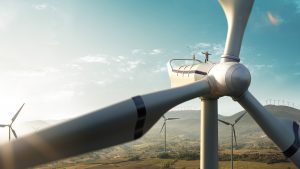Andrew Phillips, Executive Director and CFO at Lithium Power International, explores lithium’s vital role in the road to clean energy.
Lithium is a critical component in delivering a carbon-free, clean energy future. It has long been hailed as an escape route for a planet choking itself to extinction by an over-reliance on fossil fuels.
Other clean energy technologies are being deployed alongside lithium, including hydrogen and nuclear energy.
But this one element is seen as the main change for the world to kick its dependence on polluting carbon fuels. That is because, when used in batteries, it can store electricity to drive transport, power homes and industry, and bring to life pocket sized devices like mobile phones.
Oil-fired combustion engines side-lined cart horses after the First World War. In turn, they are now being supplanted by electric motors driven by lithium-ion batteries.
They can be charged again and again with electricity generated from nature’s own solar rays or wind.
The emergence of clean energy
The basics of clean energy are widely known, but its pervasive influence is much more extensive than many considered until recently.
Governments and global business enterprises now accept that this new technology will cost vast sums of capital, both monetary and political, to deploy. It carries large risks.
But global warming, and its potentially catastrophic impact on climate, waits for no one.
We can be thankful that governments are broadly in agreement. Look no further than the speed with which China, Europe, and the US are now acting to end the use of fossil fuels and ring in the advent of clean energy.
The US is developing a battery manufacturing industry
In a recent article, the US Department of Energy (DOE) outlined the challenges that lie ahead.
“When people think about scientists working on batteries to support a decarbonised future, they might think about men and women working in labs to develop new chemistries. That’s part of the story, but not all. Where are these batteries produced? Does the US have enough production capacity to support widespread EV adoption? And, once the batteries are made and put into cars, how do we know that we have enough charging stations, in the right places, to keep them running?”
In fact, since the US passed legislation last year to embrace lithium-powered technology and develop an EV manufacturing industry, a new impetus has emerged.
Thousands of new jobs have been created to retool manufacturing, spurred by grants, tax breaks, and a realisation from businesses that North America had to act quickly.
China and other Asian nations have a head-start, and there is strong demand for their batteries and electric vehicles.

Energy and environmental analyst at the DOE’s Argonne National Laboratory in Illinois, Dave Gohlke, says there has roughly been one announcement of a new EV battery development every few days since last year.
Manufacturing plans have been announced every few days, many emerging on a massive scale in terms of capital outlays and production.
“We are very interested in the number of jobs that will be created by all of this,” Gohlke explained. “That’s what people can directly relate to, and we can make a quantitative analysis of the potential gasoline and greenhouse gas reductions.”
The key states for EV battery production will be Michigan and Kentucky through to 2030. Each state is expected to supply between 97 and 136 gigawatt-hours of capacity by the end of the decade.
Other states, including Georgia, North Carolina, Ohio, Tennessee, and Kansas, will also be important.
This commitment to jobs, technology development, mining, processing, research, and financing is critical to communities that could otherwise have been confronted with lay-offs and closures.
Recycling technologies are being examined also, with the aim Argonne says to “establish a circular battery ecosystem.”
DOE and Li-Bridge plan to build a domestic US manufacturing base
DOE and Li-Bridge, a public-private alliance that includes the US battery industry, plan to build a domestic US manufacturing base and battery supply chain that will operate for many years.
They have pinpointed 26 actions to ramp up this work, such as setting up a buying consortium for raw energy materials, a system of shared pilot lines to speed commercialisation of battery technologies, a large boost in workforce training, and permitting reforms.
Their report is the first collaboration of its kind in the US battery industry, and it covers more than 40 companies including leaders and start-ups in activities such as automotive, mining, chemical, and electric utilities. The report warns, however, that impressive as this sounds, this is no slam dunk.
Dig behind the headlines, and the US knows that if it cannot establish a secure and stable supply chain within its own borders, other countries will reap the rewards of economic growth. Jobs would slump.
As it stands, about 76% of lithium battery cells and a large majority of cell components are currently made in China.
“Without reliable access to […] technology, the US has no chance of meeting its 2050 net zero carbon emissions goal or ensuring an inclusive and socially responsible industry,” Li-Bridge has warned.
US defence equipment is increasingly dependent on lithium-based batteries. The report also warns of national security risks in relying on batteries and components made abroad.
Long-term decisions in the industry are being made
To reduce costs, battery manufacturing facilities are being co-located with EV assembly plants. On one level, that is common sense. But on another, it shows that sensible long-term decisions are being made despite the hectic pace at which the industry is being rebuilt.
Investigations are underway on how to recycle materials when tomorrow’s EVs are readied for the scrap yard. This is a tricky task because batteries are loaded with a variety of chemicals that can harm the environment if not handled correctly.
Overall, the US domestic manufacturing capacity is expected to expand nearly 20-fold by 2030, Argonne estimates.

Big Oil is joining the clean energy transformation
Even Big Oil, the companies like Exxon, Shell, and BP that have become behemoths thanks to their global, integrated oil supply chains, see the writing on the wall.
Exxon has recently diversified into lithium mining. The Wall Street Journal reported that it paid $100m to buy 120,000 acres of land in Arkansas where a substantial amount of lithium exists in what is known as the Smackover Formation. Exxon is also investing in its own EV charging network and in a lithium battery venture.
Other fossil fuel producers are also hedging their bets, including Occidental Energy and BP. These giants of the oil age all know that they must join the party.
Renewables are set to dominate the power sector
Energy forecaster Bloomberg NEF has examined the tipping points that can drive a clean energy transition in the absence of policy action intervening. “The last ten years of technological development scale-up and technical experience have brought several clean energy technologies – wind and solar power, battery storage and electric vehicles – to the point where they can out-compete their fossil-burning counterparts on an economic basis in most geographies, or soon will.”
Based on this new methodology, Bloomberg NEF said that clean energy would dominate the power.







